Table of Contents
- Introduction
- Editor’s Choice
- Integration of AI and the Human Workforce Worldwide
- History of Human Machine Interface
- Human Machine Interface Market Overview
- Human Machine Interface Devices Statistics
- Human Machine Interface Usage
- Human Machine Interface Device Specifications
- Human Machine Interface Export Statistics
- Human Machine Interface Import Statistics
- Consumer Preferences Statistics
- Key Spending and Investment Statistics
- Concerns and Challenges
- Advancements in Human Machine Interface Technology Statistics
- Regulations for Human Machine Interface
- Recent Developments
- Conclusion
- FAQs
Introduction
Human Machine Interface Statistics: A Human-Machine Interface (HMI) system enables users to interact with machines or processes through hardware and software components.
It translates complex machine data into user-friendly visual displays and controls, allowing for effective monitoring and management.
HMIs can be simple, with basic controls, or advanced, featuring detailed graphics and interactive elements.
Key functions include data visualization, system control, and alarm notifications. They are used across various fields, from industrial automation to consumer electronics and medical devices.
Modern HMIs are increasingly integrated with IoT technologies and advanced analytics to enhance usability and operational efficiency.
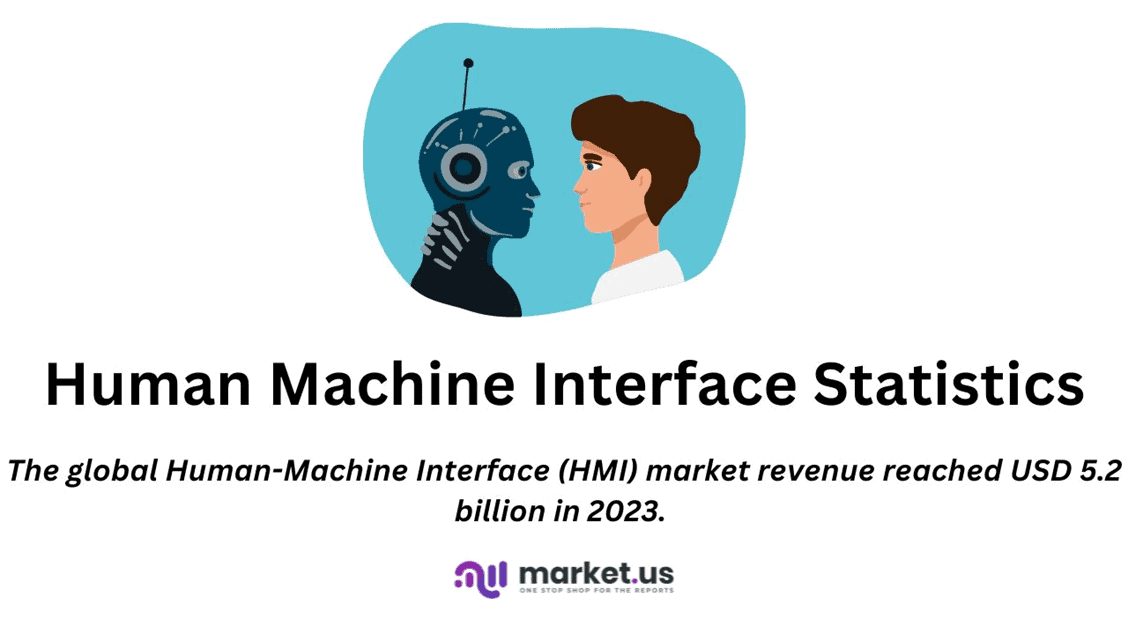
Editor’s Choice
- The history of the Human-Machine Interface (HMI) reflects the evolving relationship between humans and technology. It traces back to the 1860s with the invention of the typewriter, which is often considered the first rudimentary HMI.
- The global Human-Machine Interface (HMI) market revenue reached USD 5.2 billion in 2023.
- By 2032, the total HMI market is expected to reach USD 10.7 billion. With hardware revenue at USD 5.52 billion and software revenue at USD 5.18 billion.
- In the global Human-Machine Interface (HMI) market, system configuration is divided into two primary categories: embedded HMI and Standalone HMI. Embedded HMI holds a majority share, accounting for 58% of the market.
- In 2015, the adoption of advanced Human-Machine Interface (HMI) smart technology among firms in Italy varied across different processes. The data indicates that 16% of companies were utilizing HMI technology within smart factory processes. Reflecting the highest adoption rate among the categories.
- In the global export market for Human Machine Interface (HMI) technologies. China leads significantly with 10,194 shipments, far surpassing other exporting countries.
- India stands out as the largest importer of Human Machine Interface (HMI) technologies. With a remarkable 10,109 shipments, reflecting its substantial demand in the global market.
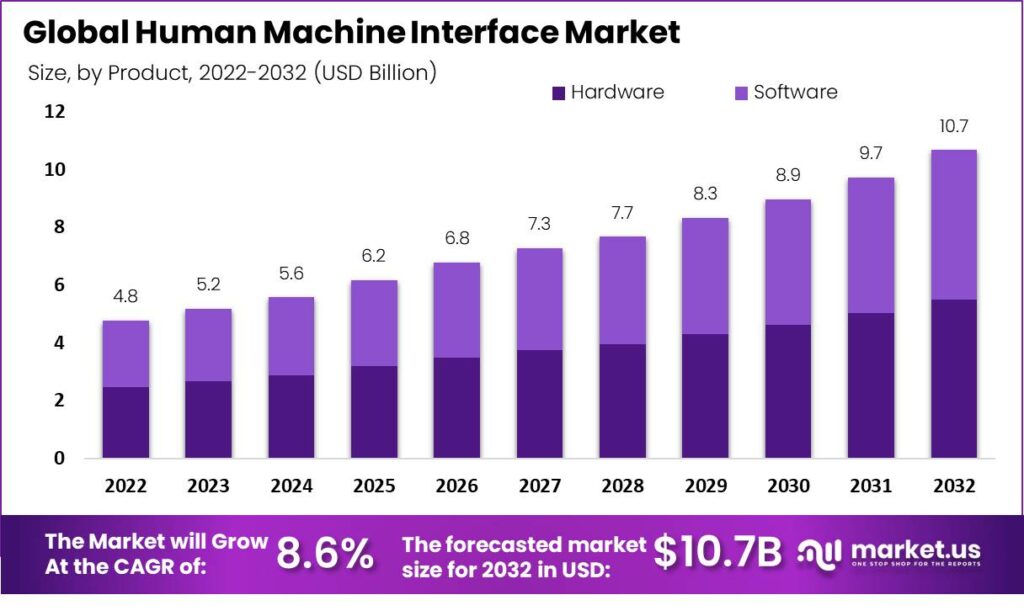
Integration of AI and the Human Workforce Worldwide
- In 2020, the integration of artificial intelligence (AI) and human workforce in organizations worldwide varied across different modes of interaction.
- A significant portion of organizations, 87%, reported that AI recommends actions while humans make the final decisions. Indicating a strong preference for human oversight in critical decision-making processes.
- Additionally, 85% of respondents indicated that AI generates insights. Which are then used by humans in their decision-making processes, underscoring the role of AI in enhancing human judgment.
- In scenarios where AI decides and implements actions autonomously, 60% of respondents reported using this mode. Demonstrating a moderate level of trust in AI’s ability to make and execute decisions independently.
- Conversely, 75% of organizations reported that AI decides, but humans are responsible for implementing these decisions. Reflecting a balanced approach where AI provides direction while humans maintain control over execution.
- Moreover, 70% of respondents indicated that humans generate the initial data or ideas, which are then evaluated by AI. Highlighting the collaborative nature of AI and human interaction in optimizing decision-making processes within organizations.
- This data illustrates the diverse roles AI plays in supporting and enhancing human decision-making across various organizational contexts.
(Source: Statista)
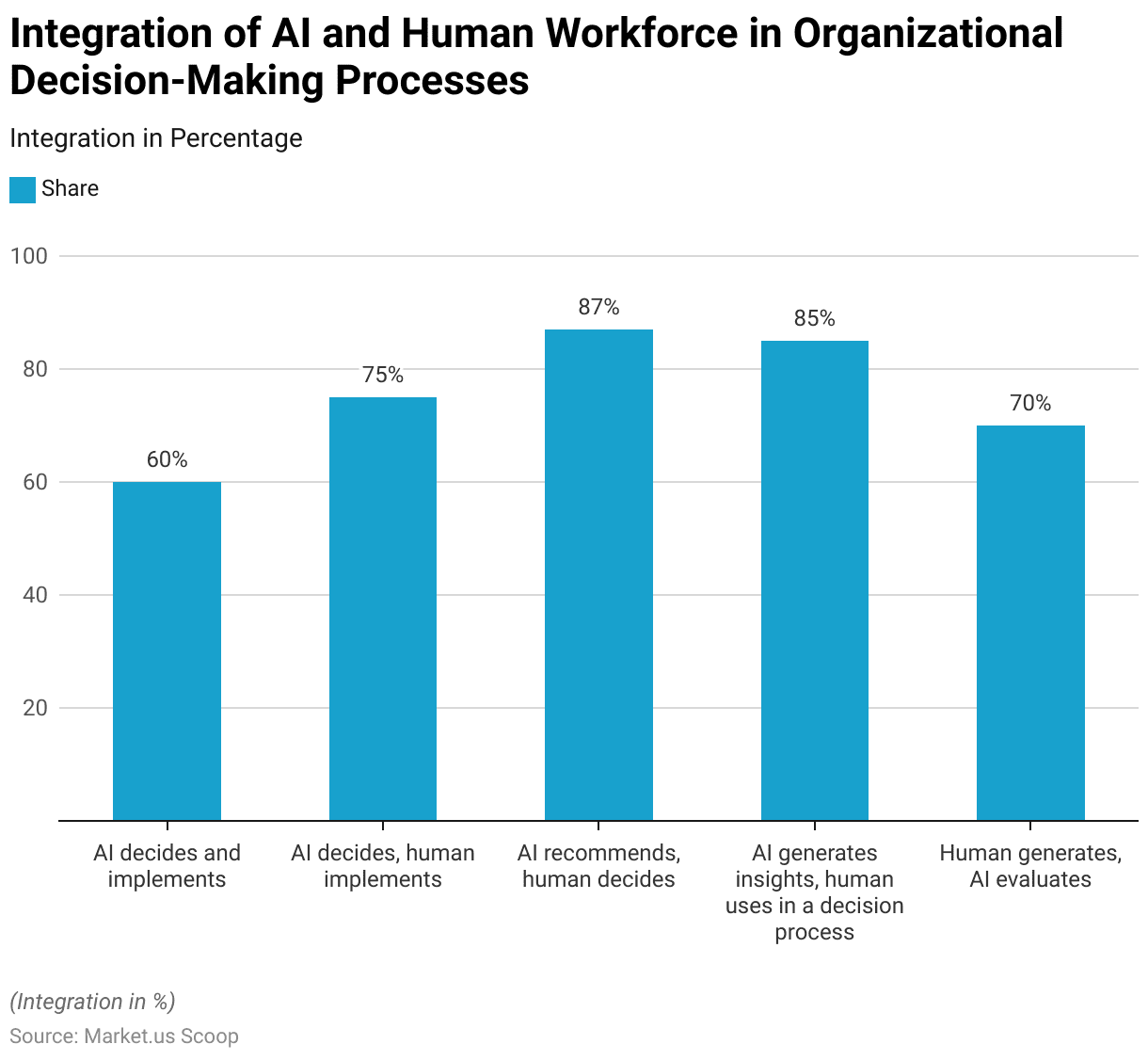
History of Human Machine Interface
- The history of the Human-Machine Interface (HMI) reflects the evolving relationship between humans and technology. Tracing back to the 1860s with the invention of the typewriter, which is often considered the first rudimentary HMI.
- As technology advanced, the 20th century witnessed the rise of computers, transitioning from mechanical interactions like punch cards to more sophisticated command-line interfaces.
- The introduction of graphical user interfaces (GUIs) in the 1970s. Particularly with the development of touchscreens, revolutionized the field, allowing more intuitive and visual interaction.
- The late 20th and early 21st centuries saw the integration of HMIs into mobile devices. With touchscreens and gesture controls becoming ubiquitous, transforming user experiences across industries.
- More recently, advancements in virtual and augmented reality, as well as voice-controlled systems, have paved the way for natural interfaces. Further blurring the lines between human input and machine response.
- These developments have been driven by continuous improvements in computing power, miniaturization, and user-centered design. Making HMI an integral part of modern technology across various sectors, including industrial automation, automotive, and consumer electronics.
(Sources: KepoTech, MRO Electric, Wevolver)
Take advantage of our unbeatable offer - buy now!

Human Machine Interface Market Overview
Global Human Machine Interface Market Size Statistics
- The global Human-Machine Interface (HMI) market is projected to experience consistent growth over the coming decade at a CAGR of 8.6%.
- In 2022, the market was valued at approximately USD 4.8 billion.
- This figure is expected to rise steadily, reaching USD 5.2 billion in 2023 and continuing to increase through the following years.
- By 2024, the market is anticipated to be valued at USD 5.6 billion. With further growth leading to a valuation of USD 6.2 billion in 2025.
- The upward trend is expected to persist, with the market reaching USD 6.8 billion in 2026 and USD 7.3 billion in 2027.
- In subsequent years, the market is forecasted to grow to USD 7.7 billion by 2028, USD 8.3 billion by 2029, and USD 8.9 billion by 2030.
- By 2031, the market is anticipated to reach USD 9.7 billion. Further expansion is projected to result in a market value of USD 10.7 billion by 2032.
- This steady growth highlights the increasing demand and adoption of HMI technologies globally.
(Source: market.us)
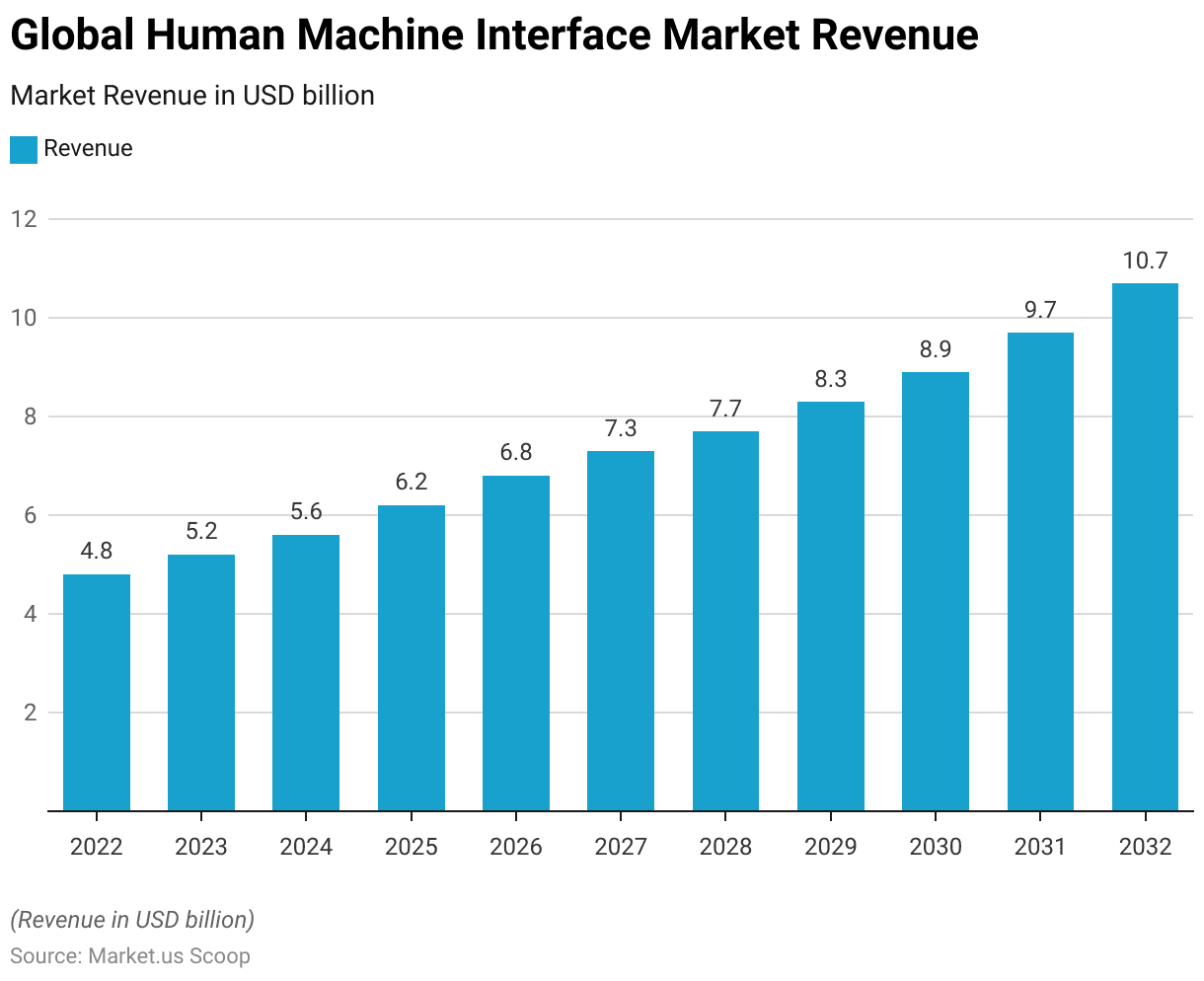
Global Human Machine Interface Market Size – By Product Statistics
2022-2026
- The global Human-Machine Interface (HMI) market is expected to see significant growth over the next decade. With both hardware and software components contributing to this expansion.
- In 2022, the total HMI market revenue was valued at USD 4.8 billion. With hardware accounting for USD 2.48 billion and software for USD 2.32 billion.
- The market is projected to grow to USD 5.2 billion in 2023. With hardware revenue increasing to USD 2.68 billion and software revenue to USD 2.52 billion.
- This trend continues through 2024 when the market is expected to reach USD 5.6 billion. With hardware and software revenues at USD 2.89 billion and USD 2.71 billion, respectively.
- By 2025, the market size is anticipated to grow to USD 6.2 billion. With hardware at USD 3.20 billion and software at USD 3.00 billion.
- The market will likely reach USD 6.8 billion in 2026, with hardware and software contributing USD 3.51 billion and USD 3.29 billion, respectively.
2027-2032
- In 2027, the market is forecasted to grow to USD 7.3 billion. With hardware generating USD 3.77 billion and software USD 3.53 billion.
- By 2028, the market size is expected to increase to USD 7.7 billion. With hardware at USD 3.97 billion and software at USD 3.73 billion.
- The year 2029 is projected to see the market grow to USD 8.3 billion. With hardware accounting for USD 4.28 billion and software for USD 4.02 billion.
- This upward trajectory is expected to continue, with the market reaching USD 8.9 billion by 2030. Where hardware and software revenues will be USD 4.59 billion and USD 4.31 billion, respectively.
- By 2031, the market is anticipated to expand to USD 9.7 billion. With hardware generating USD 5.01 billion and software USD 4.69 billion.
- Finally, by 2032, the total HMI market is expected to reach USD 10.7 billion. With hardware revenue at USD 5.52 billion and software revenue at USD 5.18 billion.
- This consistent growth underscores the increasing demand for both hardware and software components in the HMI market.
(Source: market.us)

Global Human Machine Interface Market Share – By Configuration Statistics
- In the global Human-Machine Interface (HMI) market, the configuration of systems is divided into two primary categories: Embedded HMI and Standalone HMI.
- Embedded HMI holds a majority share, accounting for 58% of the market. This indicates a strong preference for integrated solutions where HMI functionalities are embedded within other systems or devices.
- On the other hand, Standalone HMI, which refers to independent HMI systems that operate separately from other systems, represents 42% of the market.
- This distribution highlights the significant presence of embedded systems in the HMI market. Reflecting the industry’s inclination towards integrated and compact solutions.
(Source: market.us)
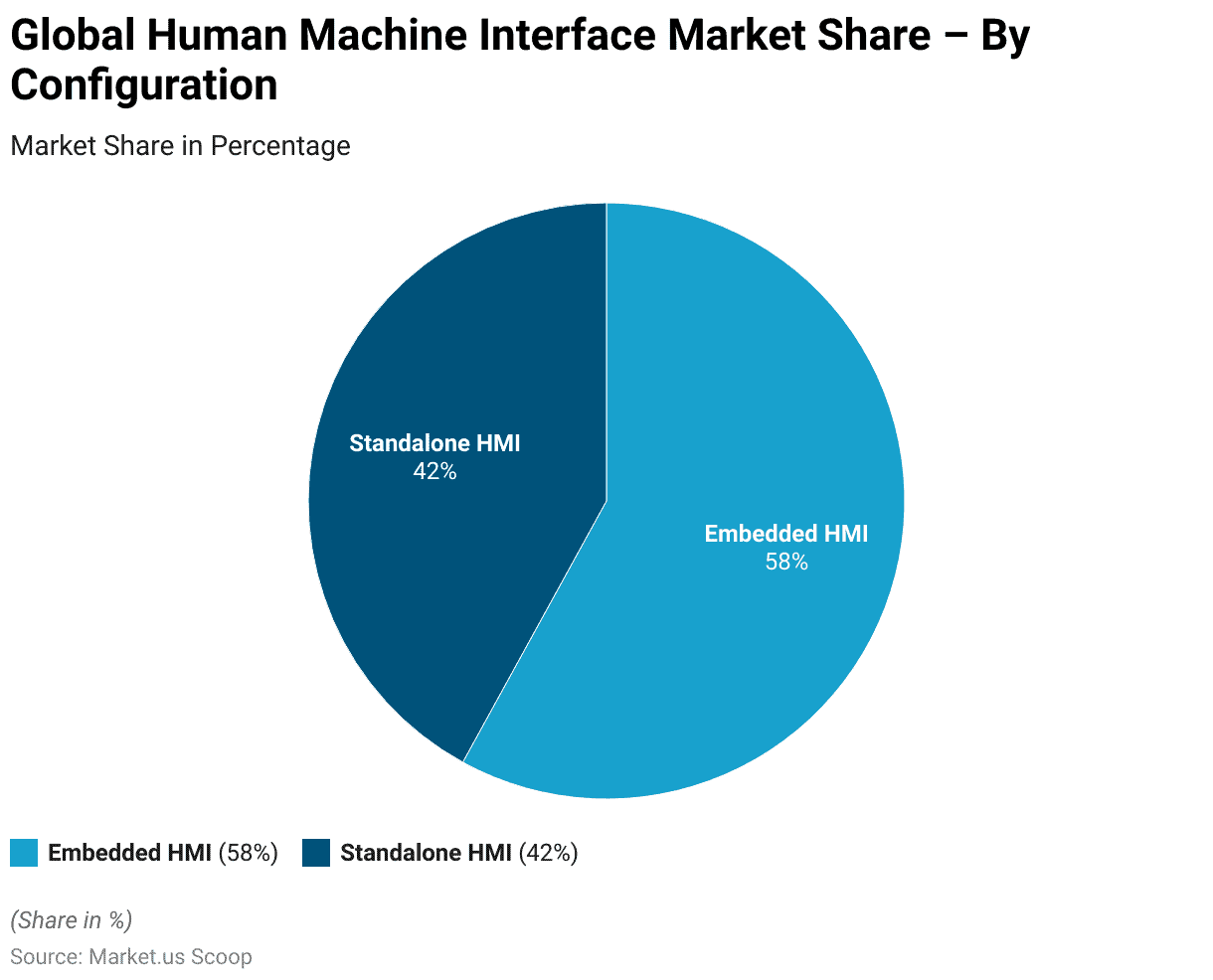
North American Human Machine Interface (HMI) Market Size Statistics
- The North American Human-Machine Interface (HMI) market has experienced substantial growth between 2019 and 2027.
- In 2019, the market was valued at USD 0.86 billion.
- By 2027, it is projected to more than double, reaching USD 1.81 billion.
- This significant increase reflects the rising demand for HMI technologies across various industries in North America. Driven by advancements in technology and the growing need for efficient and user-friendly interfaces.
(Source: Statista)
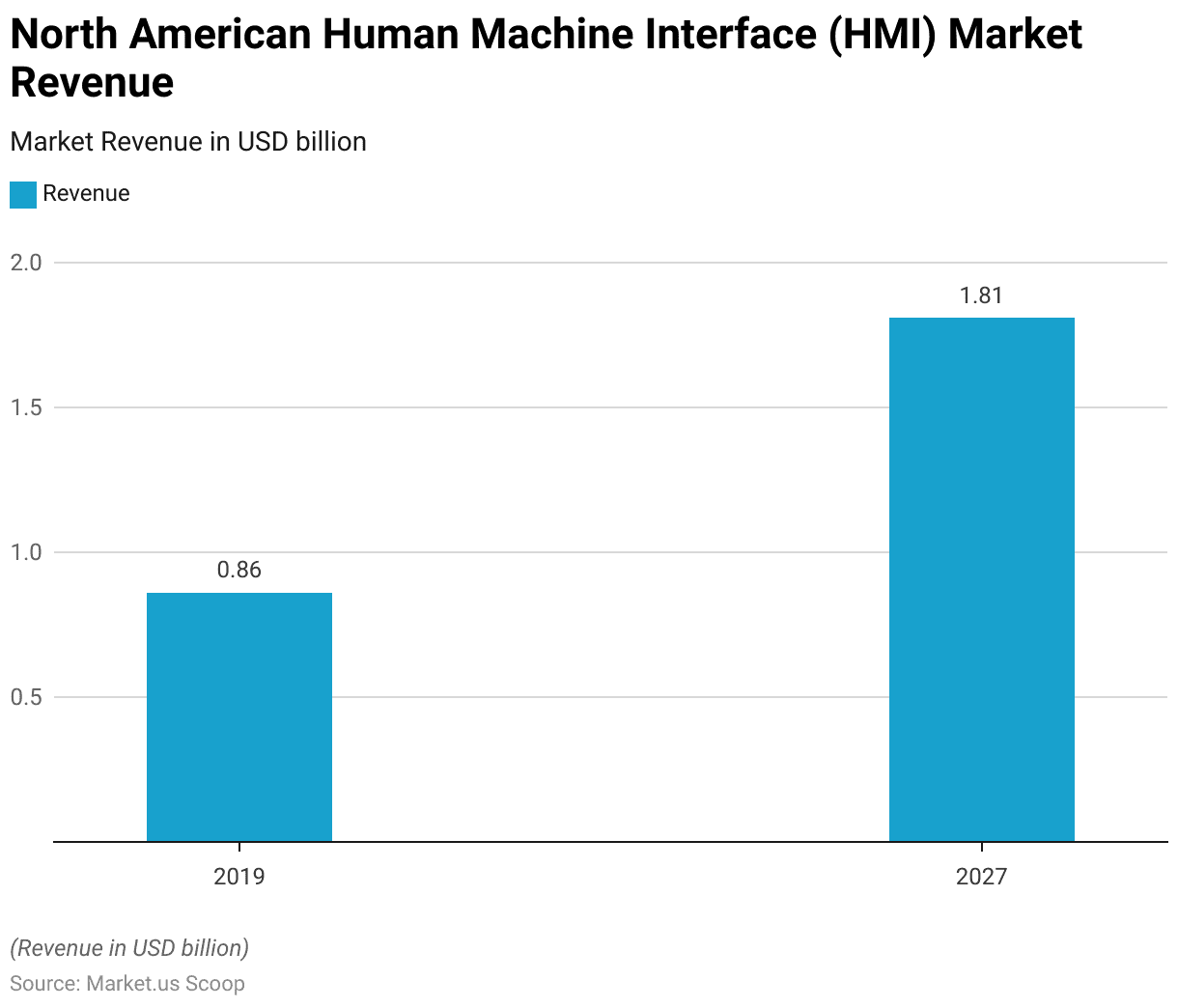
Europe Human Machine Interface (HMI) Market Size Statistics
- The European human-machine Interface (HMI) market has demonstrated significant growth between 2019 and 2027.
- In 2019, the market was valued at USD 1.35 billion.
- By 2027, it is projected to more than double, reaching USD 2.85 billion.
- This growth reflects the increasing adoption of HMI technologies across various industries in Europe. Driven by technological advancements and the rising demand for efficient and user-friendly interfaces.
(Source: Statista)
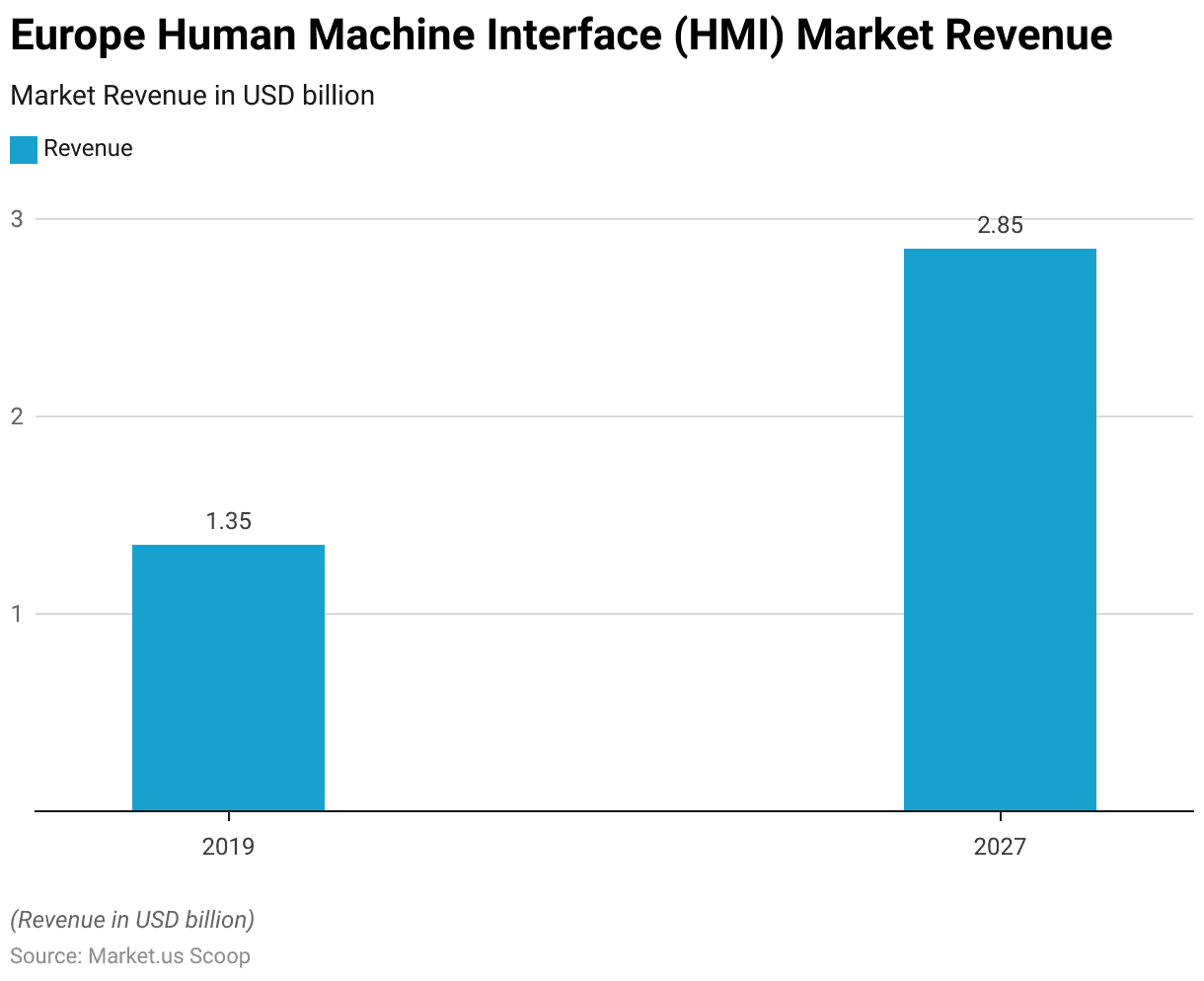
Human Machine Interface Devices Statistics
2020-2024
- The number of Human-Machine Interface (HMI) dedicated augmented reality (AR) and virtual reality (VR) devices worldwide is projected to grow significantly from 2020 to 2030 across both enterprise and consumer contexts.
- In 2020, there were 2 million enterprise devices and 8 million consumer devices in use.
- By 2021, these numbers increased to 4 million for enterprise and 14 million for consumer devices.
- This growth trend continues, with enterprise devices reaching 5 million and consumer devices 18 million in 2022.
- The upward trajectory is expected to persist, with 6 million enterprise devices and 24 million consumer devices projected for 2023.
- By 2024, the numbers are forecasted to rise to 8 million enterprise devices and 31 million consumer devices.
2025-2030
- The year 2025 is anticipated to see further increases, with 10 million enterprise devices and 38 million consumer devices.
- From 2026 to 2030, the growth in AR and VR devices dedicated to HMI remains strong.
- In 2026, 12 million enterprises and 45 million consumer devices are expected. Growing to 14 million and 53 million, respectively, in 2027.
- By 2028, enterprise devices are projected to reach 16 million, with consumer devices at 60 million.
- The trend continues with 18 million enterprise devices and 67 million consumer devices by 2029. Culminating 21 million enterprises and 73 million consumer devices by 2030.
- This data underscores the robust expansion of AR and VR technologies within the HMI sector across both enterprise and consumer markets.
(Source: Statista)
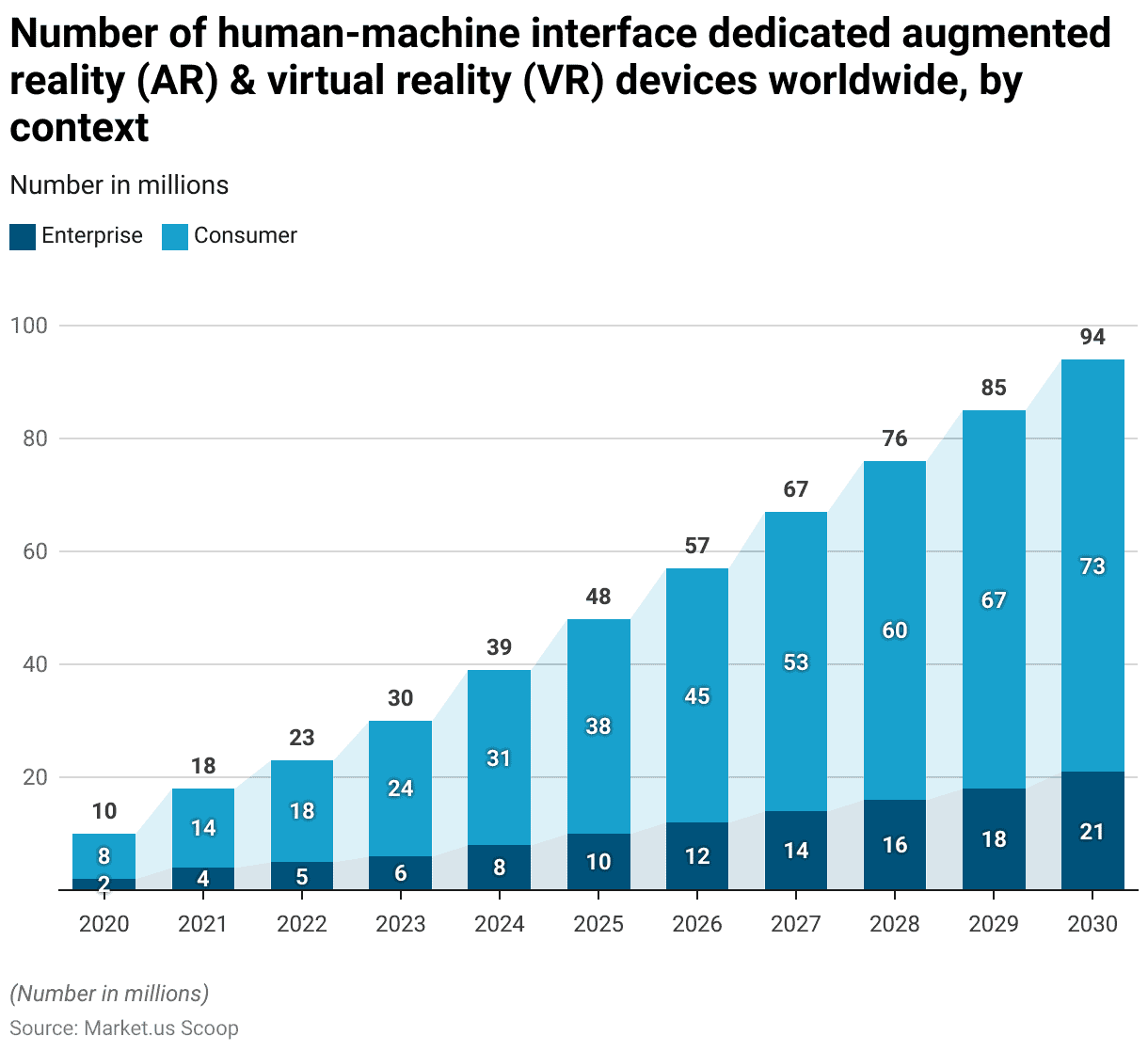
Human Machine Interface Usage
- In 2015, the adoption of advanced Human-Machine Interface (HMI) smart technology among firms in Italy varied across different processes.
- The data indicates that 16% of companies were utilizing HMI technology within smart factory processes, reflecting the highest adoption rate among the categories.
- In contrast, 8% of firms implemented HMI in smart lifecycle management. While 4% of companies applied this technology to optimize their smart supply chain processes.
- This distribution highlights a greater emphasis on integrating HMI technology within manufacturing and factory settings than other business processes.
(Source: Statista)
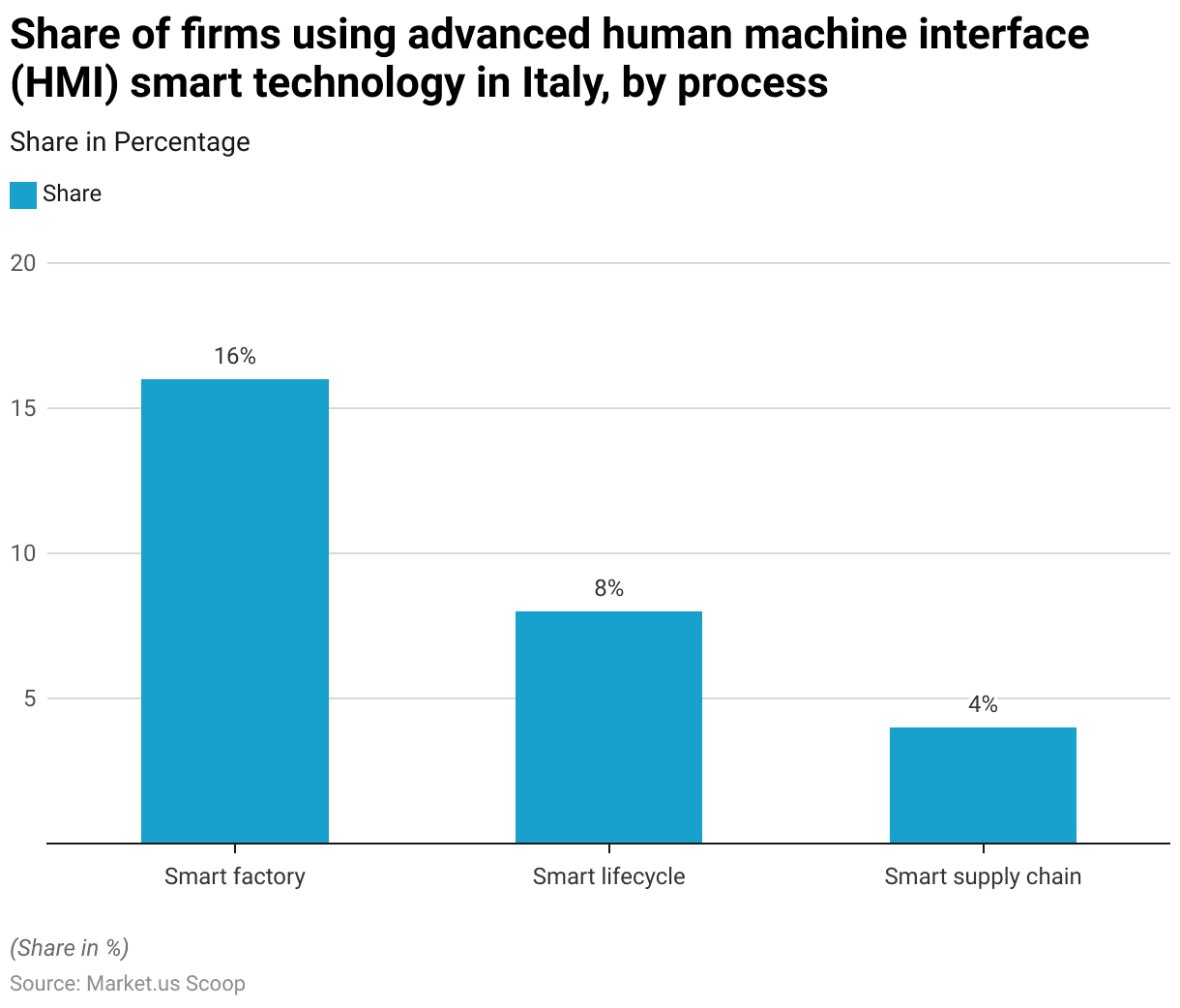
Human Machine Interface Device Specifications
The Trainnet® Human Machine Interface Statistics
- The Trainnet® Human-Machine Interfaces (HMI) come in various models with distinct technical specifications.
- The 6.5-inch model has dimensions of 220 x 170 x 125 mm, weighs 3.7 kg, and operates on either 24 V DC or 110 V DC input power. It features a display resolution of 640 x 480 (VGA) with an active display area of 133 x 99 mm, offering a luminance of 440 cd/m².
- The typical power consumption ranges from 3.5 W in standby mode (no image) to 11 W at full brightness.
- The 12.1-inch models, including the standard and FT versions, have dimensions of 340 x 270 x 106 mm and 320 x 260 x 75 mm, respectively, with a weight of 6 kg.
- These models operate on 24 V DC, 72 V DC, or 110 V DC for the standard version and 110 V for the FT version. Both 12.1-inch models feature a display resolution of 1024 x 768 (XGA), with an active display area of approximately 246 x 184 mm.
- They provide a luminance of 320 cd/m², with typical power consumption ranging from 4 W in standby mode to 15 W at full brightness.
- All models are designed to operate within a temperature range of -25 °C to +70 °C and have a Mean Time Between Failures (MTBF) of 50,000 hours at an ambient temperature of 40 ºC.
- The displays support a color depth of 262,144 and offer varying viewing angles, with the 6.5-inch model providing a viewing angle of -5050° horizontally and -6030° vertically. While the 12.1-inch models offer a wider viewing angle of –6565° horizontally and –7545° vertically.
(Source: EKE Electronics)
MK070E-33DT Human Machine Interface Statistics
- The MK070E-33DT HMI features a 7-inch TFT display with a resolution of 800×480 pixels and supports 256K colors.
- It has a brightness of 250 cd/m², an LED backlight with a life of 50,000 hours, and a 4-wire precision resistance touch panel.
- Powered by a 700 MHz RISC processor, it includes 128MB Flash memory, 64MB DDR2, and expandable memory via a USB host.
- The device supports various communication protocols through two RS485 ports and features nine digital inputs/outputs and two analog inputs/1 output.
- It supports up to 8 KS Series expansion modules.
- With dimensions of 204 x 150 x 33.9 mm, it operates on 24 VDC, consumes 10W of power, and is designed for an operating temperature range of 0° to +50°C.
- The HMI is IP65-rated for front panel protection and uses natural air cooling.
(Source: Kinco Automation)
Omron NYE Series Human Machine Interface Statistics
- The Omron NYE Series HMI is a dedicated standard HMI designed for industrial applications, featuring a color graphics display and touchscreen interaction.
- It is available in three models: NYE2A-20S11-07WR1200, NYE2A-20S11-07WR1300, and NYE2A-20S11-09WR1200.
- All models are designed for Type 1, 4X enclosures intended for indoor use only and are rated for hazardous locations (Class 1 Division 2). They comply with international standards (UL, CSA, CE) and a wide range of maritime standards (ABS, NK, LR, DNV, RINA, BV, GL, KR, CR, GOST-R, EAC).
- The NYE2A-20S11-07WR1200 and NYE2A-20S11-07WR1300 models feature a 7-inch TFT color LCD with a resolution of 800 x 480 pixels, while the NYE2A-20S11-09WR1200 model has a 9-inch TFT color LCD with the same resolution.
- Each model includes 900 MB of memory, two built-in Ethernet ports, one built-in USB slave, and supports Compact Flash memory cards.
- The HMIs are designed for landscape mounting orientation, with the NYE2A-20S11-07WR1200 and NYE2A-20S11-09WR1200 models featuring a black bezel and the NYE2A-20S11-07WR1300 model featuring a silver bezel.
(Source: Omron)
Applied Analytics Human Machine Interface Statistics
- The Applied Analytics HMI features an 8.0-inch diagonal screen with a resolution of 800×600 pixels and a 4:3 display ratio.
- It includes an overlay resistive touchscreen with a brightness of 350 cd/m².
- Powered by an Intel® Celeron™ 1.83GHz processor, the system is equipped with 4GB of memory and a solid-state drive (SSD) for storage, utilizing a 1.8” half-size SATA.
- The HMI supports Ethernet connectivity through two RJ-45 ports and includes a BIOS by AMI/UEFI.
- It operates on a 24VDC power supply, consuming 14.5W, and is designed to function within an operating temperature range of 0°C to 50°C, with a storage temperature range of –20°C to 60°C.
- The HMI operates in humidity levels between 10% and 90% relative humidity, non-condensing, and has a Mean Time Between Failures (MTBF) of 40,000 hours.
- Additional connectivity options include one RS-232 serial port, one RS-485 serial port, and two USB 2.0 ports. Storage options include SATA and SD card support.
(Source: Applied Analytics)
XV300 Advanced Human Machine Interface Statistics
- The XV300 Human Machine Interface (HMI) features a sleek, tablet-like design with capacitive multi-touch technology (PCT). It is available in high-resolution widescreen displays of 7” (1024×600), 10.1” (1024×600), and 15.6” (1366×768), with the option to set up in portrait mode.
- The front panel is heavy-duty, easy to clean, and equipped with toughened, anti-reflective glass, making it ideal for demanding environments.
- Powered by an 800 MHz ARM Cortex-A9 CPU with a high-performance graphics processing unit, the XV300 offers 1 GB of internal memory, 120 KB of retained memory for PLC functions, and 512 MB of RAM. It also includes an SD card slot for memory extension, system operation from removable memory, or easy installation of system updates.
- The device is equipped with two independent Ethernet interfaces, ensuring safe segregation between the control level and function-specific field level. Depending on the device version, it offers comprehensive interfaces, including one or two Ethernet ports, USB host and device ports, CAN, RS-232, RS-485, SmartWire-DT, and PROFIBUS-DP/MPI/PPI.
- The 7” and 10.1” XV300 devices support rear mounting, enabling a control console installation that creates a flat, edge-free surface, meeting strict hygienic requirements.
- The XV300 series is certified with various standards, including CE, cUL, cUL Class 1 Div 2, and ATEX Zone 22, with additional certifications for the 15” units in preparation.
- It is also classified by the Maritime Classification Society DNV-GL (Environmental Category C, EMC1), with similar certification for 15” units in preparation.
- The HMI is combined with powerful Eaton HMI/PLC software, including Galileo and XSOFT-CODESYS-3, and supports PLC functions with field bus interfaces such as CANopen, J1939, Ethernet/IP, EtherCAT, Modbus (TCP/RTU), SmartWire-DT, and PROFIBUS-DP.
(Source: Eaton)
Human Machine Interface Export Statistics
- In the global export market for Human Machine Interface (HMI) technologies, China leads significantly with 10,194 shipments, far surpassing other exporting countries.
- Taiwan ranks second with 549 shipments, followed by Japan with 492 shipments.
- India contributes 379 shipments, while Austria accounts for 300.
- Germany, with 134 shipments, and South Korea, with 123, are also notable exporters.
- Brazil and Indonesia follow closely with 118 and 115 shipments, respectively.
- Other countries with significant HMI export activities include Italy (98 shipments), the United States (91), France (85), Hong Kong (61), Turkey (56), and Finland (47).
- This data highlights China’s dominant role in the HMI export market, with other countries contributing considerably smaller volumes.
(Source: Volza)
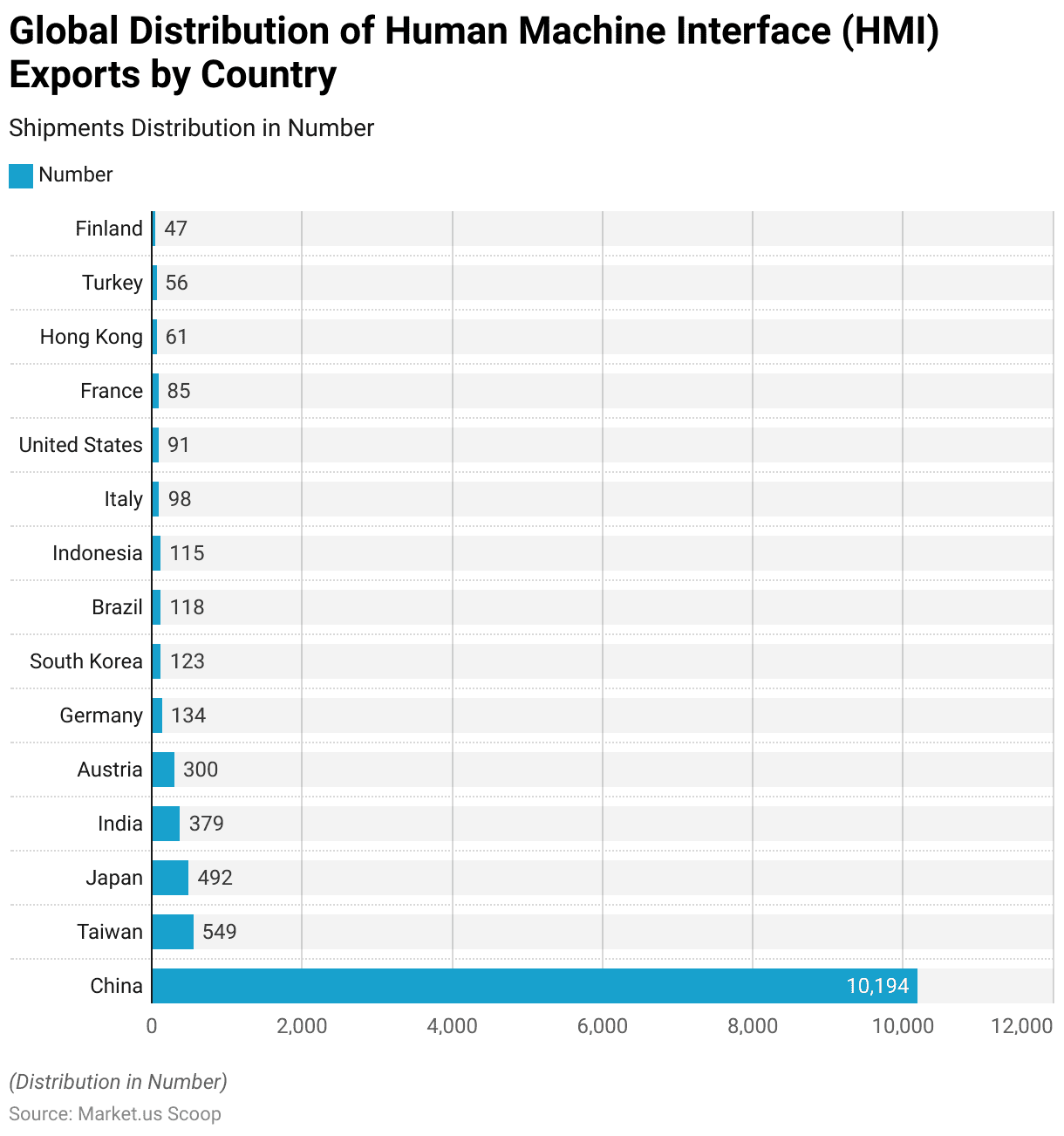
Human Machine Interface Import Statistics
- India stands out as the largest importer of Human Machine Interface (HMI) technologies, with a remarkable 10,109 shipments, reflecting its substantial demand in the global market.
- Vietnam follows with 487 shipments, while Peru imports 442 shipments.
- Russia also shows significant activity with 422 shipments, closely followed by the United States, which accounts for 394 shipments.
- Other notable importers include the Philippines with 276 shipments, Indonesia with 176, and Sri Lanka with 129.
- Ukraine and Pakistan also contribute to the global import landscape with 108 and 96 shipments, respectively.
- Turkey, Brazil, and Italy each account for 60-65 shipments, while Bangladesh and
- Kazakhstan has smaller but notable import activities, with 53 and 45 shipments, respectively.
- This data underscores India’s leading position in the global import of HMI technologies, with a diverse range of countries also actively participating in the market.
(Source: Volza)
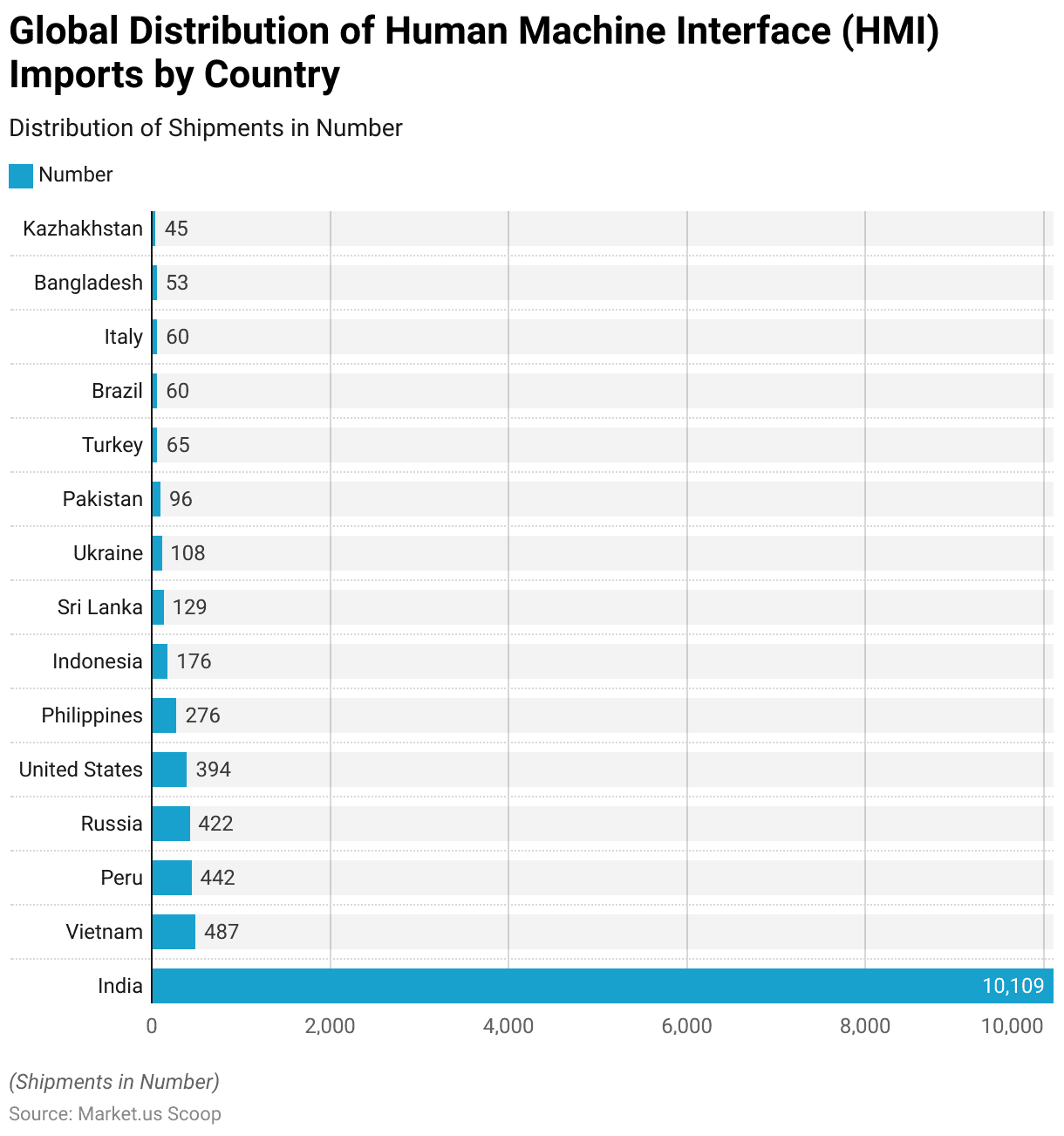
Consumer Preferences Statistics
Preferences for Automation vs. Human Interaction in Customer Service Across Generations
- In 2023, customer preferences for automation versus human interaction in customer service varied significantly across generations in the United Kingdom.
- Generation Z showed the highest preference for automated services for simple issues, with 68% favoring automation, yet 58% of this group still expect a human to respond immediately when they contact a company.
- Millennials similarly expressed a strong preference for automation at 65%, with an even higher expectation (66%) for immediate human response.
- Generation X showed slightly less inclination towards automation, with 59% preferring it and 55% expecting instant human interaction.
- Baby boomers were the least likely to favor automation, with only 39% preferring it, while 43% expected immediate human response.
- Overall, 56% of all respondents preferred automated services for simple issues, with an equal percentage (56%) expecting a prompt human response when needed.
- This data highlights generational differences in expectations for customer service interactions in the UK.
(Source: Statista)
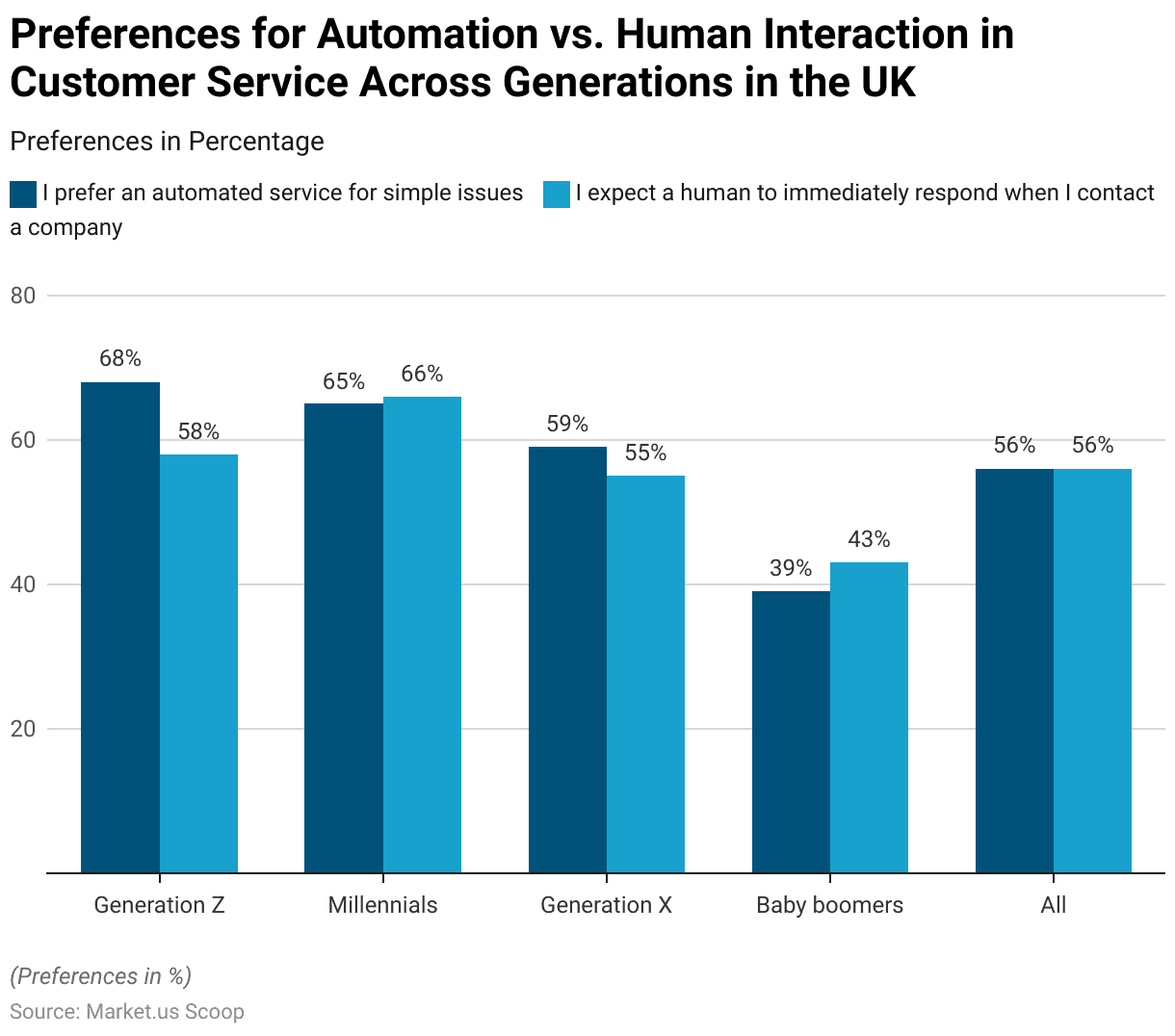
Preference for Human-driven vs. AI-driven Media Content
- As of February 2023, a majority of adults in the United States demonstrated a strong preference for human-driven media content across various types of media.
- For online news articles or websites, 69% of respondents favored human-created content, with only 12% preferring AI-driven alternatives.
- Similarly, 69% preferred human-generated content for photojournalism or pictures used in news stories, while just 12% opted for AI-generated content.
- In the realm of artistic photos and illustrations, 64% of respondents expressed a preference for human creation, compared to 14% who preferred AI-driven content.
- When it came to customer marketing websites, 60% of adults favored human-created content, with 15% leaning toward AI-generated content.
- For movies intended for streaming networks or theatrical release, 58% of respondents preferred human-driven production, while 18% favored AI involvement.
- Lastly, for videos meant for personal use, 65% of adults preferred human creation, while 13% indicated a preference for AI-driven content.
- This data highlights a clear inclination towards human-driven content in various media forms despite the growing capabilities of AI in content creation.
(Source: Statista)
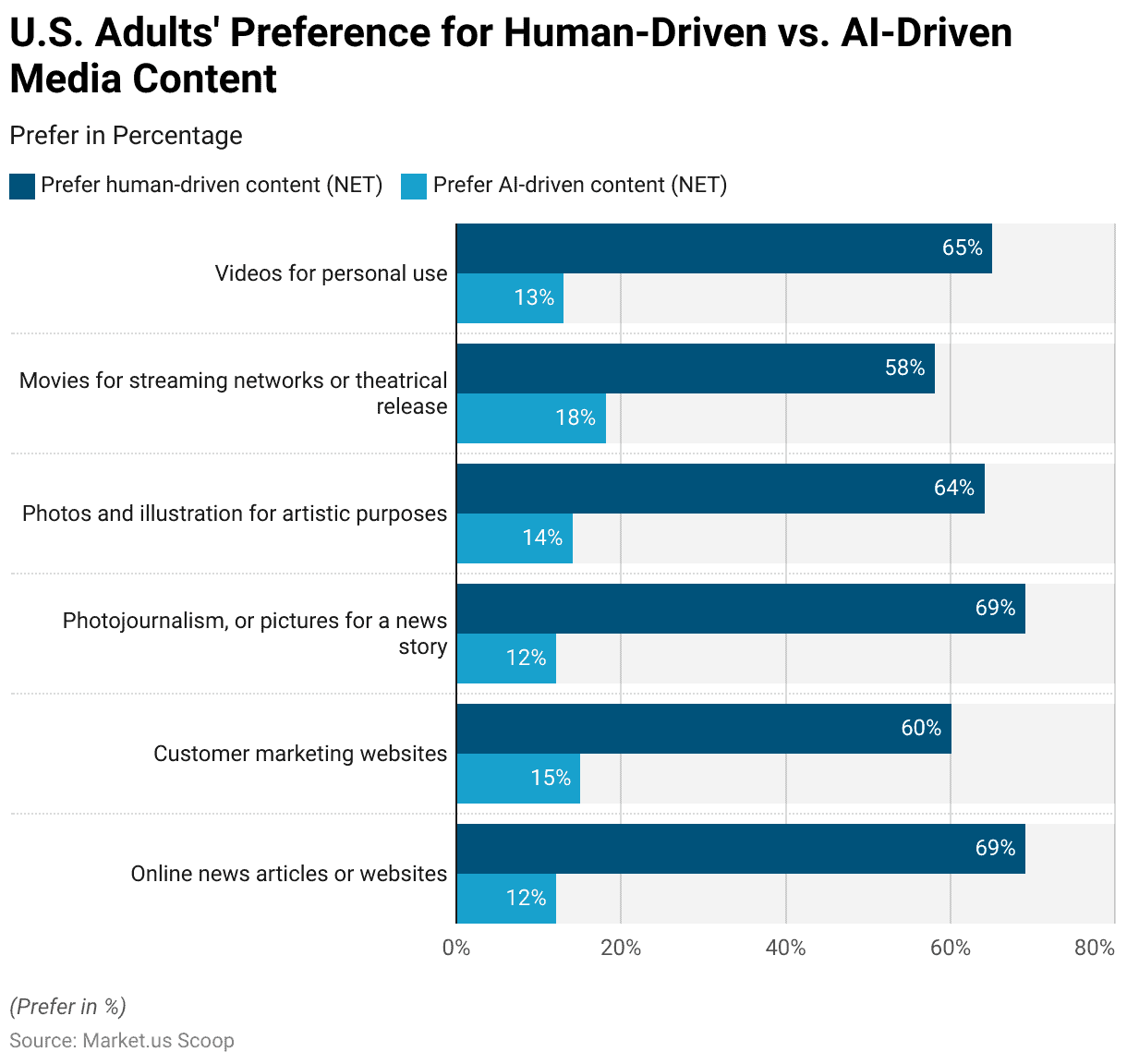
Technology Adoption in Warehouse Automation
- The adoption of advanced technologies in warehouse automation is expected to see substantial growth between 2019 and 2030.
- In 2019, blockchain technology was utilized by 8% of warehouses, but by 2030, its adoption is projected to increase significantly to 45%.
- Artificial Intelligence (AI) saw an 11% adoption rate in 2019, with expectations of a dramatic rise to 75% by 2030.
- Robotics and automation technologies were employed by 36% of warehouses in 2019, with an anticipated growth of 85% by 2030.
- Supply chain 4.0, which encompasses IoT and analytics, had a 45% adoption rate in 2019 and is projected to reach 90% by 2030, indicating widespread integration of these technologies in future warehouse operations.
- Cloud computing and storage, already fairly well adopted in 2019 at 54%, is expected to grow to 80% by 2030.
- This data highlights the rapid advancement and integration of various technologies in warehouse automation, underscoring a trend toward increased efficiency and innovation in supply chain management.
(Source: Statista)
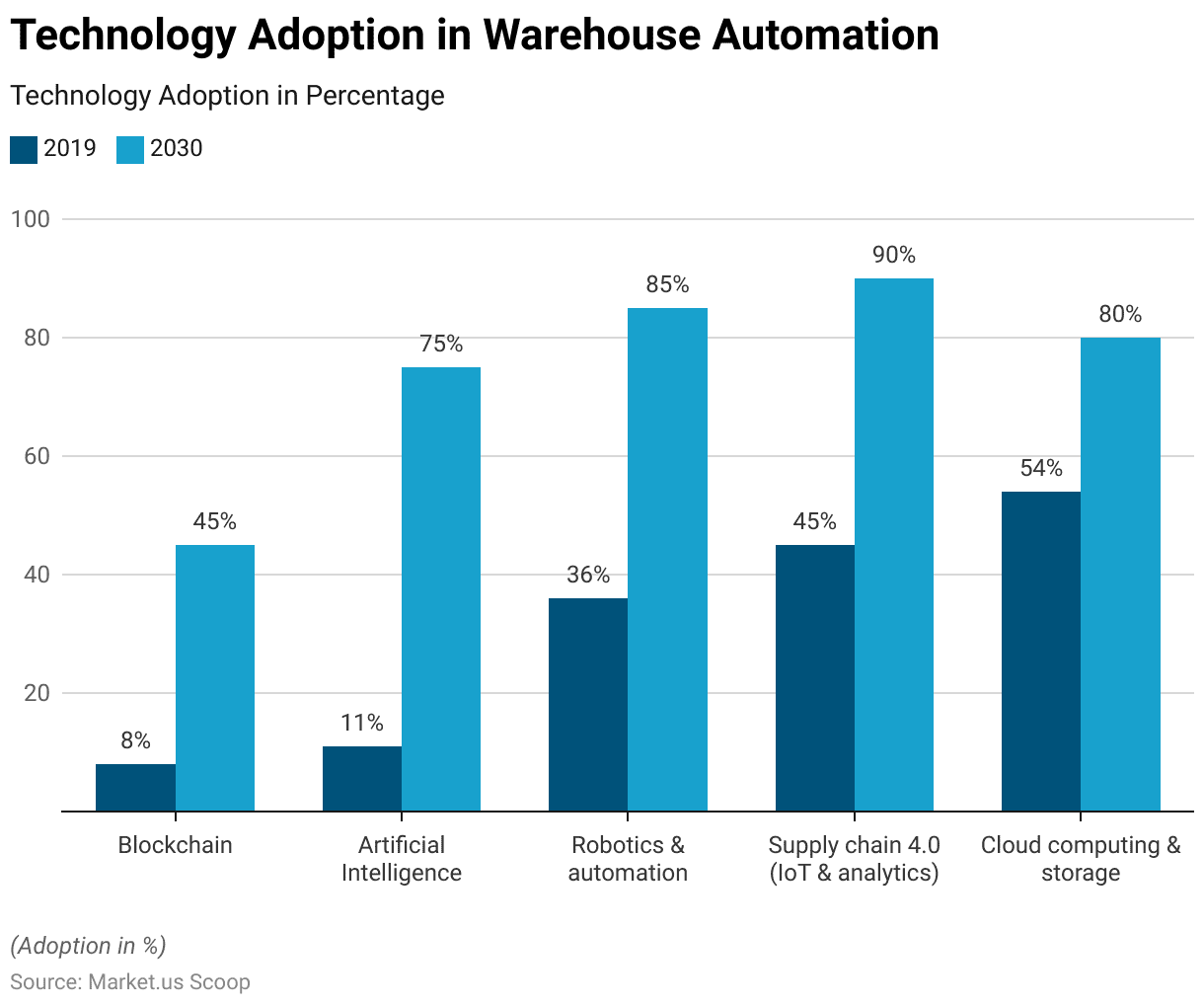
Key Spending and Investment Statistics
- From 2016 to 2023, global spending on Robotic Process Automation (RPA), Intelligent Process Automation (IPA), and AI for business operations experienced significant growth.
- In 2016, RPA spending was relatively modest at $0.3 billion, while IPA spending reached $4.8 billion, and AI business operations accounted for $0.7 billion.
- Over the years, investment in these technologies has grown substantially. By 2017, RPA spending had more than doubled to $0.8 billion, IPA reached $5.9 billion, and AI spending increased to $1.1 billion.
- This upward trend continued with RPA spending hitting $1.9 billion in 2018, while IPA and AI expenditures rose to $7.1 billion and $1.6 billion, respectively.
- By 2019, RPA spending reached $2.9 billion, IPA grew to $8.4 billion, and AI for business operations increased to $2.3 billion.
- The year 2020 saw further expansion, with RPA at $4 billion, IPA at $9.6 billion, and AI business operations at $3.1 billion.
- The growth accelerated in 2021, with RPA spending at $5.4 billion, IPA at $10.9 billion, and AI business operations at $4 billion.
- By 2022, spending on RPA had risen to $7.2 billion, IPA reached $12.1 billion, and AI business operations surged to $6.8 billion.
- Finally, in 2023, RPA spending peaked at $10.4 billion, while IPA reached $13 billion, and AI business operations saw a significant increase to $10.8 billion.
- This data underscores the rapid adoption and increasing reliance on automation and AI technologies in business operations worldwide over this period.
(Source: Statista)
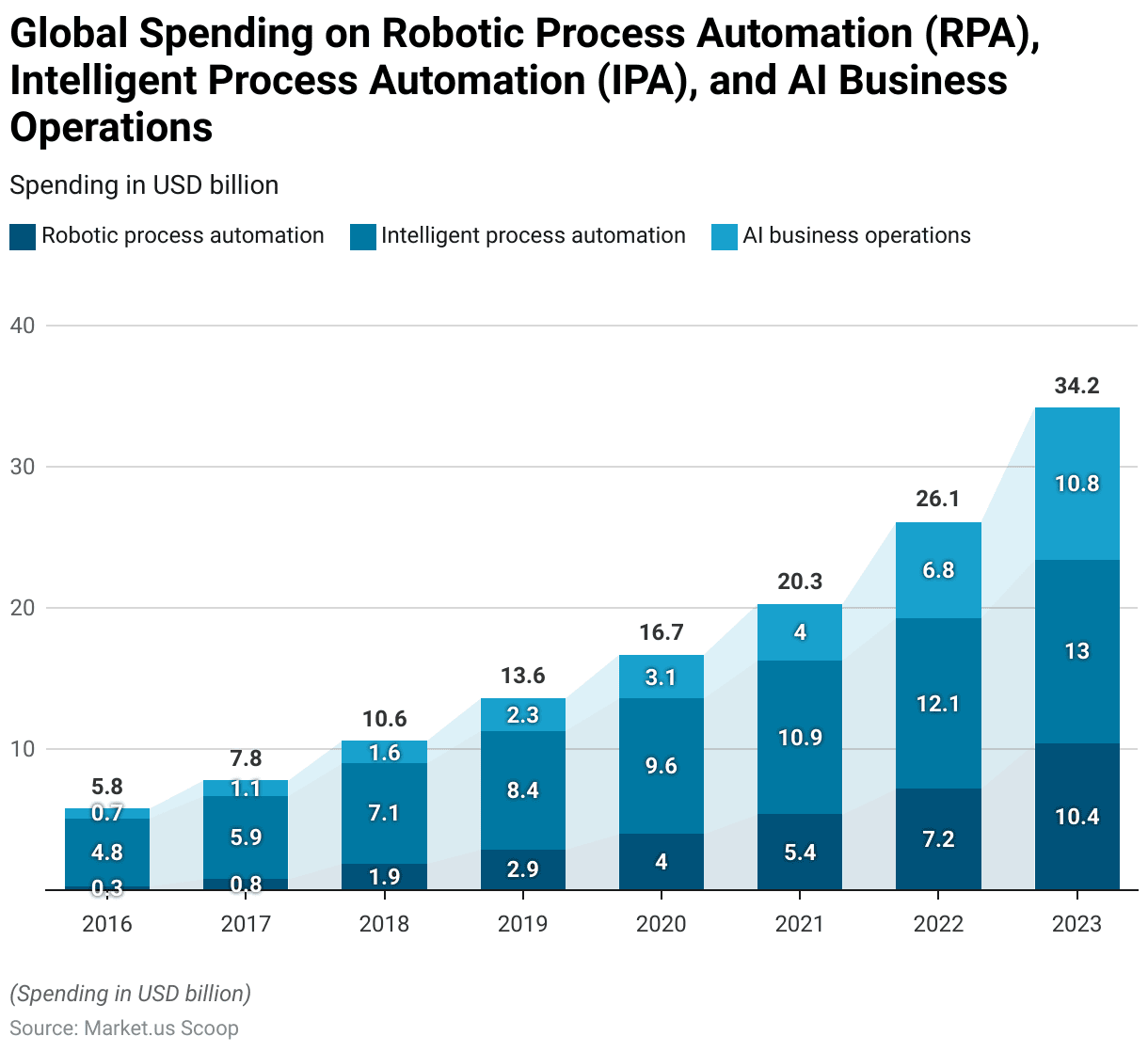
Global Total Corporate Artificial Intelligence (AI) Investment
- Global corporate investment in Artificial Intelligence (AI) has seen significant growth over the period from 2015 to 2022.
- In 2015, the total investment stood at USD 12.75 billion.
- This figure increased to USD 17.7 billion in 2016, marking the beginning of a rapid expansion in AI investment.
- The year 2017 saw a dramatic rise, with investments soaring to USD 44.08 billion.
- While 2018 saw a slight dip to USD 43.81 billion, the upward trend continued in 2019, reaching USD 48.85 billion.
- The growth accelerated further in 2020, with total corporate AI investment climbing to USD 67.85 billion.
- The peak of this trend was in 2021 when investment reached an all-time high of USD 93.5 billion.
- However, 2022 saw a slight decrease, with global AI investment totaling USD 91.9 billion.
- This data reflects the increasing prioritization of AI technologies by corporations worldwide, with investment levels consistently rising, particularly in the latter half of the decade.
(Source: Statista)
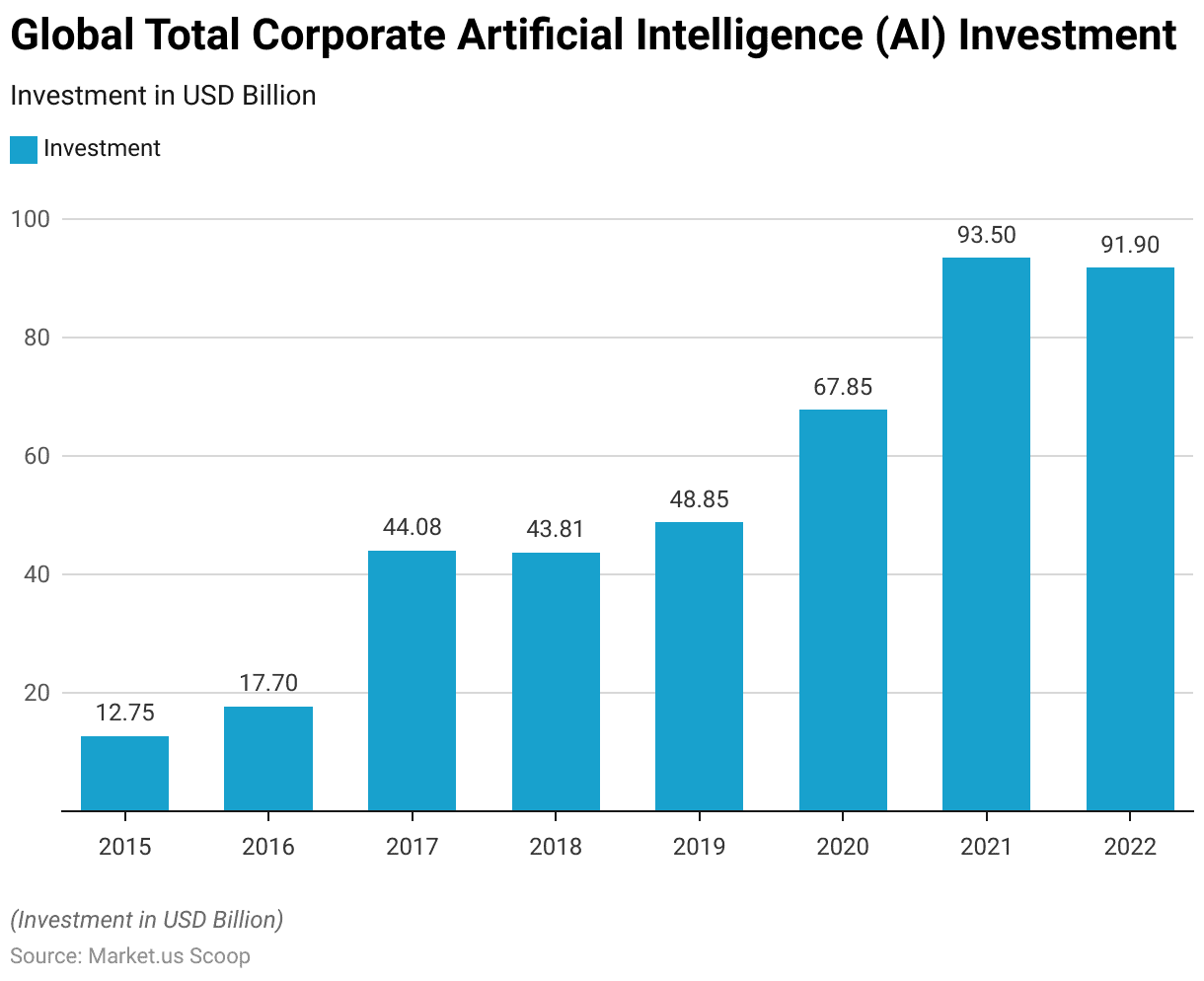
Concerns and Challenges
Global Concerns About AI and Automation Replacing Human Jobs
- In 2021, concerns about artificial intelligence (AI) and automation replacing human jobs varied significantly across different countries.
- In Portugal, 62% of respondents expressed worry about this issue, making it the country with the highest level of concern.
- South Africa followed closely with 61%, and Spain with 59%.
- In France, Australia, and New Zealand, 40% of respondents were concerned about AI and automation’s impact on employment.
- Italy and the United States both reported a 39% concern rate among their populations.
- In Ireland, 35% of respondents expressed anxiety over job displacement due to automation and AI.
- The United Kingdom and Switzerland had slightly lower concern levels, with 33% and 32% respectively.
- The Netherlands showed a lower rate of concern at 26%, while Germany had the least concern, with only 22% of respondents expressing worry about AI and automation replacing human jobs.
- This data highlights the varying levels of concern across countries, reflecting differing perceptions and potential impacts of AI and automation on the workforce globally.
(Source: Statista)

Risk of Job Automation by AI Across Industries
- In 2023, various industries in the United States faced differing levels of risk regarding job automation by artificial intelligence (AI).
- The office and administrative support sector was at the highest risk, with 46% of its positions vulnerable to automation.
- The legal industry followed closely, with 44% of jobs at risk.
- Architecture and engineering roles were also significantly affected, with 37% of positions at risk, while life, physical, and social science jobs faced a 36% risk.
- Business and financial operations, community and social service, and management positions had 35%, 33%, and 32% of their roles at risk, respectively.
- Sales and related positions saw a 31% risk of automation, while computer and mathematics jobs were at a 29% risk.
- In healthcare, both practitioners and technical roles, as well as healthcare support, faced a 28% risk of automation.
- Protective services also had 28% of positions at risk, followed by educational instruction and library roles at 27%, and arts, design, entertainment, sports, and media positions at 26%.
- Overall, 25% of positions across all industries were at risk of automation by AI.
- Personal care and service roles faced a 19% risk, while food preparation and serving-related jobs were at a 12% risk.
- Transportation and material moving positions had an 11% risk, and production roles faced a 9% risk.
- The construction and extraction industry saw 6% of jobs at risk, followed by installation, maintenance, and repair at 4%, and building and grounds cleaning and maintenance at only 1%.
- This data highlights the varying degrees of impact AI could have on job automation across different industries in the US.
(Source: Statista)
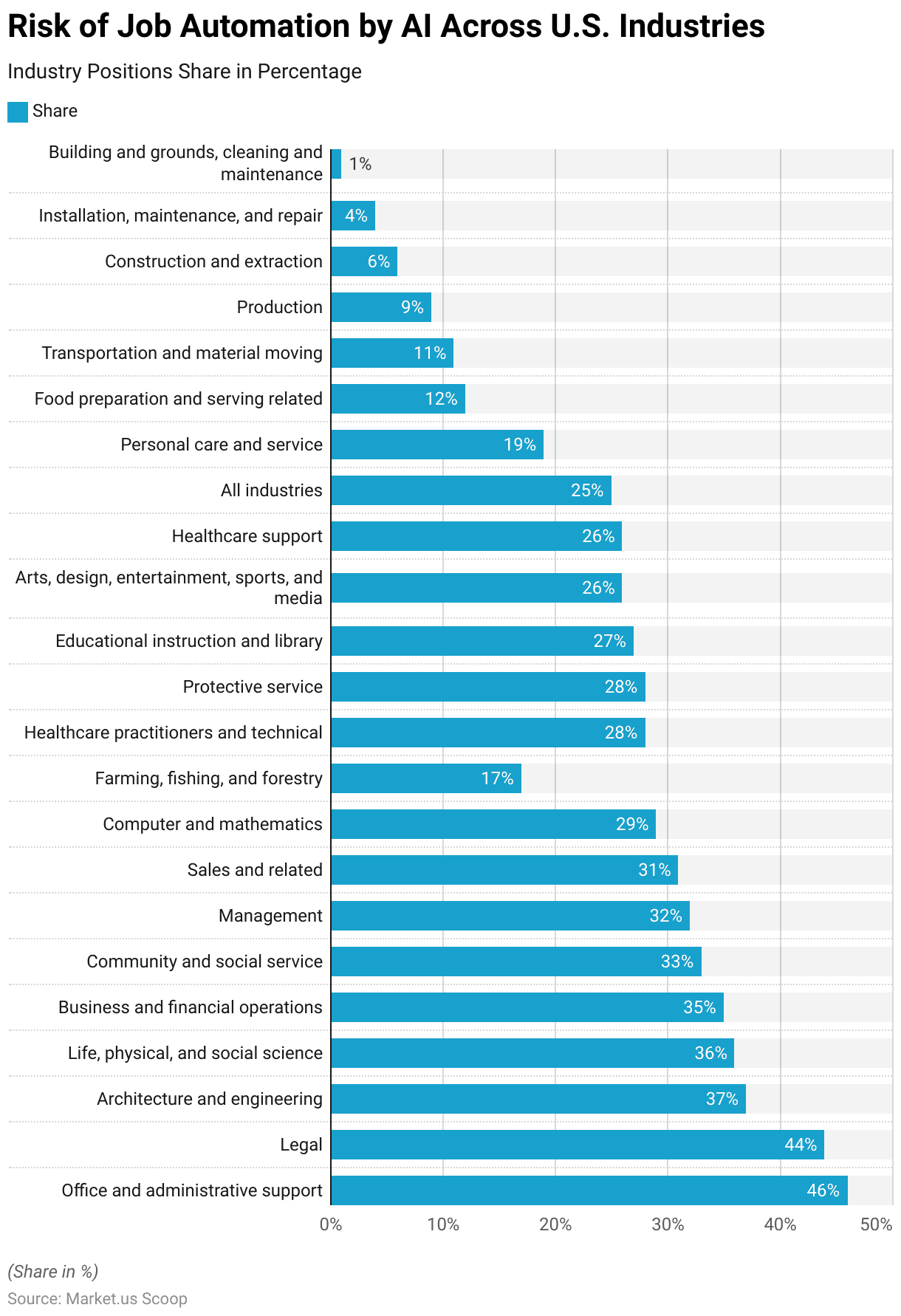
Advancements in Human Machine Interface Technology Statistics
- Recent advancements in Human-Machine Interface (HMI) technology are revolutionizing how humans interact with machines across various industries.
- Modern HMIs have evolved significantly from the early days of mechanical switches and basic displays to highly sophisticated systems incorporating artificial intelligence (AI), gesture recognition, and augmented reality (AR).
- These technologies enhance usability, enabling more intuitive and efficient interactions. For example, gesture control and voice recognition are increasingly prevalent in industrial settings, allowing for hands-free operations in hazardous environments.
- AI is also transforming HMIs by enabling interfaces to learn from user behavior, making them more responsive and personalized.
- Additionally, innovations such as flexible displays and smart surfaces are leading to more immersive and aesthetically pleasing designs.
- The integration of IoT and cloud technologies further enhances HMI capabilities, enabling real-time monitoring and remote access.
- Products like AI-driven dashboards and AR-enhanced interfaces are becoming essential tools in industries ranging from manufacturing to healthcare, driving greater efficiency, safety, and user satisfaction.
(Sources: rinf. tech, Mochuan Drives, Software Development Company, Halfnine)
Regulations for Human Machine Interface
- Human-machine interface (HMI) regulations vary significantly across countries. Reflecting different levels of technological development, safety standards, and legal frameworks.
- In the United States, HMI systems are primarily regulated by the Occupational Safety and Health Administration (OSHA) and the Federal Communications Commission (FCC), ensuring workplace safety and managing communication protocols.
- The European Union enforces stringent standards through directives such as the Machinery Directive 2006/42/EC. Which mandates comprehensive safety requirements for HMI systems used in industrial machinery.
- Moreover, the General Data Protection Regulation (GDPR) impacts HMI systems that handle personal data, emphasizing user privacy.
- Japan follows its own set of guidelines focusing on both safety and user ergonomics, while China‘s regulatory landscape is evolving rapidly. With new standards emerging to address both industrial automation and consumer electronics.
- These regulations are increasingly influenced by international standards, such as those from the International Electrotechnical Commission (IEC). Which seeks to harmonize safety and interoperability across borders.
- As HMI technology advances, global regulatory bodies are likely to tighten standards further. Particularly in areas involving artificial intelligence and data security.
(Sources: Default, Robotics Tomorrow)
Recent Developments
Acquisitions and Mergers:
- Rockwell Automation acquires Kalypso: In 2023, Rockwell Automation, a leader in industrial automation, acquired Kalypso, a digital innovation consulting firm, for $250 million. This acquisition is expected to boost Rockwell’s HMI capabilities by integrating Kalypso’s expertise in AI, IoT, and industrial operations.
- Schneider Electric merges with Aveva: In mid-2023, Schneider Electric completed its merger with Aveva, a software company specializing in industrial HMI solutions, in a deal valued at $5 billion. This merger aims to strengthen Schneider’s digital transformation offerings, enhancing its presence in the industrial HMI market.
New Product Launches:
- Siemens launches Simatic HMI Unified Comfort Panels: In early 2024, Siemens introduced its new Simatic HMI Unified Comfort Panels, designed to offer advanced visualizations, intuitive touch interfaces, and edge computing capabilities. This product caters to the industrial sector, improving user interaction with machinery.
- Honeywell releases Forge Worker Assist: In 2023, Honeywell launched Forge Worker Assist, an HMI platform that provides real-time data and analytics through wearable devices and tablets. This innovation helps industrial workers operate more efficiently by providing hands-free access to machine data and safety alerts.
Funding:
- Beckhoff Automation secures $100 million for HMI innovation: In 2023, Beckhoff Automation, a German-based company, raised $100 million to further develop its HMI technology, focusing on enhancing the user experience in smart manufacturing environments. The funding will support the integration of AI into HMI systems, enabling more predictive and responsive interfaces.
- Mitsubishi Electric invests $150 million in HMI R&D: In 2024, Mitsubishi Electric announced a $150 million investment to accelerate research and development in advanced HMI technologies, particularly for smart factories and autonomous systems. This investment aims to improve real-time interaction and machine-learning integration.
Technological Advancements:
- AI-Powered HMIs: AI is becoming integral to the development of intelligent HMI systems, providing users with predictive data and real-time insights. By 2025, over 35% of HMI solutions are expected to incorporate AI to enable predictive maintenance, adaptive user interfaces, and improved machine control.
- Augmented Reality (AR) Integration: The integration of AR into HMI systems is gaining traction, particularly in industrial applications. By 2026, AR-powered HMI systems are projected to account for 20% of the market, as they offer more intuitive and immersive control over complex machinery.
Market Dynamics:
- Growth in the HMI Market: This growth is driven by the increasing adoption of automation across industries such as manufacturing, automotive, and healthcare, coupled with advancements in user interface technology.
- Rising Demand in Automotive and Industrial Sectors: The automotive and industrial sectors are leading the demand for HMI systems. By 2025, 45% of HMI market revenue is expected to come from the automotive sector. Driven by the rise of autonomous vehicles and advanced driver-assistance systems (ADAS), along with demand for smart manufacturing solutions.
Conclusion
Human Machine Interface Statistics – In conclusion, the Human-Machine Interface (HMI) sector is poised for significant growth and evolution as it integrates increasingly advanced technologies such as artificial intelligence, automation, and connectivity.
As industries across the globe continue to adopt HMI solutions, the demand for more intuitive. User-friendly and efficient interfaces will rise, driving innovation in both hardware and software.
The ongoing advancements in HMI technology will not only enhance productivity and operational efficiency. But also reshape how humans interact with machines in various sectors, from manufacturing and healthcare to transportation and beyond.
As these technologies evolve, they will play a critical role in enabling smarter, more responsive systems that can adapt to the dynamic needs of modern industries, paving the way for a more interconnected and automated future.
FAQs
A Human-Machine Interface (HMI) is a user interface or dashboard that connects a person to a machine, system, or device. It allows users to interact with and control machines or processes by providing input and receiving feedback through visual displays, touchscreens, buttons, or other input methods.
HMI technology is used across a wide range of industries, including manufacturing, automotive, energy, healthcare, transportation, and consumer electronics. Each industry uses HMI to monitor, control, and optimize the performance of machines and systems.
HMI improves operational efficiency by providing operators with real-time data, alerts, and control options in an intuitive format. This allows for quicker decision-making, reduces downtime, and enhances the overall productivity of machinery and processes.
While HMI and SCADA (Supervisory Control and Data Acquisition) systems are related, they serve different functions. HMI is focused on the interface that operators use to interact with machines. SCADA, on the other hand, is a system that collects and analyzes data from various HMI interfaces and other sources to provide a broader view of operations across an entire plant or facility.
Security concerns with HMI systems include unauthorized access, cyber-attacks, and data breaches. To mitigate these risks, it is essential to implement strong cybersecurity measures. Including encryption, user authentication, regular software updates, and network segmentation.
Discuss your needs with our analyst
Please share your requirements with more details so our analyst can check if they can solve your problem(s)



